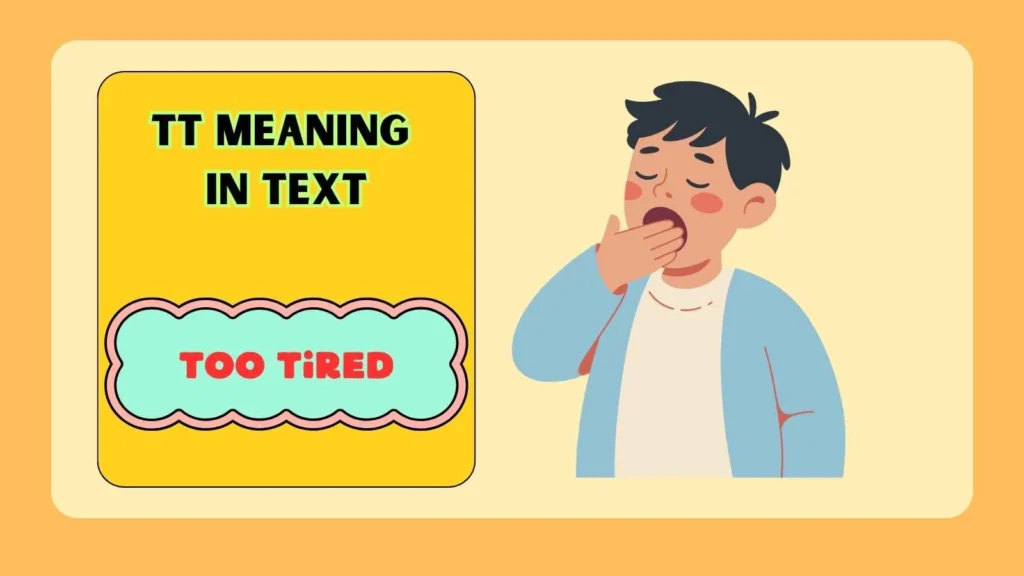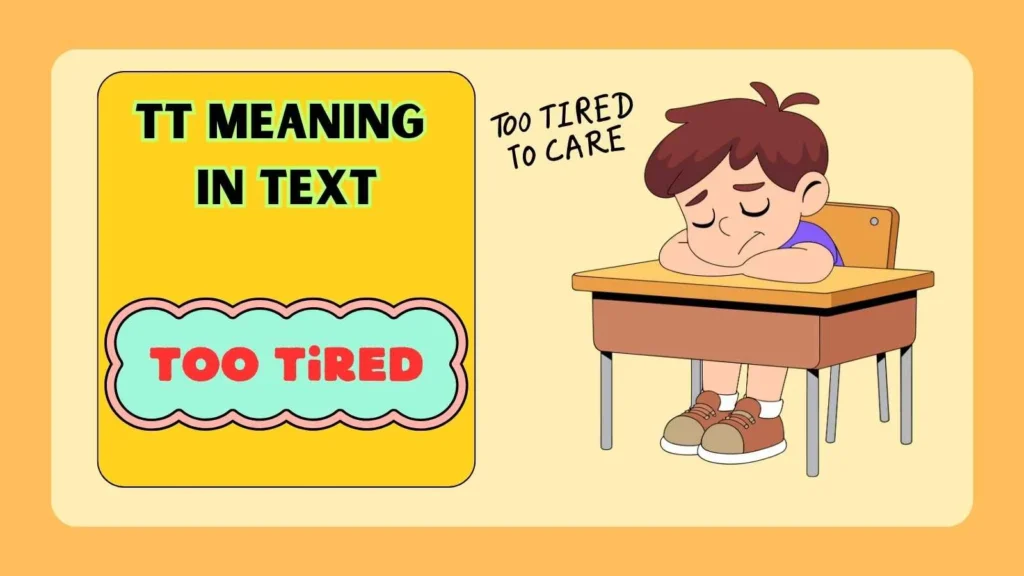Last updated on October 31st, 2025 at 10:35 pm
If you’ve come across “TT” in a text or social media chat and felt puzzled, you’re not alone. This small abbreviation often leaves people wondering what it actually stands for. In the fast-paced world of texting, abbreviations and symbols evolve quickly, and “TT” is no exception.
It can represent a range of meanings from emotional expressions to specific phrases depending on context and tone. Whether you’re decoding a message from a friend, scrolling through TikTok comments, or chatting in a group, understanding the TT meaning in text helps you stay fluent in online slang.
In this guide, we’ll explore what “TT” means, its origins, how it’s used in different contexts, and how you should respond when someone sends it your way.
Definition & Meaning
The term TT in text most commonly represents an emoji-like expression showing sadness or crying. The two capital “T” letters symbolize streaming tears from eyes, resembling a crying face. It’s a creative form of emotional shorthand used to express sadness, frustration, or disappointment. For example:
- “I missed the concert TT” means “I’m so sad I missed the concert.”
- “That ending made me cry TT” expresses emotional impact or heartbreak.
Beyond this, “TT” can also stand for other phrases such as “Transformation Tuesday,” “Toot Toot,” or “Too Tired,” depending on the context. However, its most widespread usage still points to the crying or teary-eyed emotion.
Background & History
The origins of “TT” trace back to early internet forums, chat rooms, and anime communities in the 2000s. Fans began using text-based emoticons to depict emotions, long before emoji keyboards became popular. The “TT” crying face was part of a larger set of ASCII-style expressions like “T_T” or “;_;” used by anime and gaming fans to show sadness or emotional distress.
Over time, as texting and online messaging evolved, the simplified version “TT” became common in casual communication. It moved from niche internet slang to mainstream use on platforms like Twitter, TikTok, and Instagram, where users love blending visual symbols with words for emphasis.
Usage in Various Contexts
“TT” can appear in different contexts, and its meaning shifts slightly depending on tone and platform:
- Text Messages: Often used to express sadness or sympathy.
Example: “You’re leaving tomorrow TT” - Social Media Posts: Used humorously or dramatically to show exaggerated emotion.
Example: “Can’t believe my phone just died TT” - Gaming or Anime Chats: Indicates emotional reactions to storylines or outcomes.
Example: “That ending scene TT I’m crying.” - Fan Communities: Sometimes used alongside hashtags like #TT to express reactions to characters, idols, or shows.
Its flexible emotional tone from genuinely sad to playfully dramatic — is what makes it so adaptable online.
Common Misconceptions & Clarifications
Many people confuse “TT” with:
- “TikTok” – While “TT” is sometimes shorthand for the TikTok app (especially in hashtags or bios), that’s a different context entirely.
- “Talk To” or “Too Tired” – Some users interpret “TT” as an abbreviation for phrases like “too tired” or “talk to,” depending on the conversation.
- “Transformation Tuesday” – On Instagram, “TT” might stand for the weekly fitness trend “Transformation Tuesday.”
👉 Clarification: Context is everything. The meaning changes based on tone, topic, and platform.
Similar Terms & Alternatives
Here are a few similar emotional expressions and alternatives to “TT”:
- T_T or T.T – Classic crying emoticon versions.
- 🙁 or :’( – Common sad faces in text messages.
- 😭 or 😢 – Emoji equivalents on modern keyboards.
- Sobbing / Crying / Sad – Written alternatives for formal contexts.
Each variation shows sadness or frustration but differs in tone and intensity.
How to Respond to This Term
When someone sends “TT,” your reply should match the mood:
- If they’re sad: Offer comfort.
“Aww, don’t be sad TT, things will get better!” - If they’re being dramatic: Play along humorously.
“Haha, same TT, Mondays are the worst!” - If unclear: Politely ask for clarification.
“Wait, what does TT mean here?”
The key is empathy — respond in a way that fits the emotional tone.
Regional or Cultural Differences
While “TT” originated in East Asian online culture (especially Japan and Korea), it has since spread globally. In Korean texting, “TT” is commonly read as “crying face” and often paired with phrases like “TT TT 너무 슬퍼” (“I’m so sad TT TT”). Western users later adopted it from K-pop fandoms and anime culture.
In some regions, especially among younger users, “TT” can also double as shorthand for TikTok, depending on the topic. The cultural blend between Asian internet slang and global meme culture has helped the term thrive worldwide.
Comparison with Similar Terms
Let’s see how TT compares with other emotional slang:
| Term | Meaning | Tone | Usage |
|---|---|---|---|
| TT | Crying or sadness | Casual | Texting, anime, fan chats |
| T_T | Crying face (more emotional) | Emotional | Online chats |
| 😭 | Loud crying emoji | Playful to dramatic | Social media |
| 🙁 | Sad face | Mild sadness | Text messages |
| LOL | Laughing | Opposite emotion | Humor or irony |
In short, TT sits comfortably between expressive text slang and visual emoji culture — emotional, but still lighthearted.
Usage in Online Communities & Dating Apps
In online communities, “TT” adds emotional flair to posts and comments. It’s often used in fan pages, gaming discussions, or meme threads to express disappointment or affection.
On dating apps, it can signal playful vulnerability:
- “You unmatched me TT” might mean “I’m jokingly sad you stopped replying.”
It’s a subtle way of showing emotion without sounding too serious — a staple of Gen Z and millennial texting style.
Hidden or Offensive Meanings
Unlike some internet slang, “TT” isn’t inherently offensive. However, its meaning can shift depending on the conversation:
- In certain adult or slang-heavy chats, “TT” might appear in explicit contexts (e.g., referring to “twin things” or body parts).
- Always consider the sender’s tone and setting before assuming intent.
In general, “TT” remains a safe, emotional, and widely acceptable expression in normal texting.
Suitability for Professional Communication
In formal or professional communication, avoid using “TT.” While it’s friendly in personal chats, it’s too casual for emails or workplace messaging. Instead, express emotions directly with phrases like “I’m disappointed” or “That’s unfortunate.”
In professional settings, using TT can make you appear unprofessional or overly informal, especially in client or business communications.
💬 What Does TT Mean in Texting from a Girl

- 💖 “TT” often stands for “Teary-eyed” or crying face emoji, showing emotion.
- 😢 Many girls use TT to express sadness, frustration, or sympathy.
- 💬 Sometimes, it simply replaces the 😭 emoji for quick typing.
- 💕 In flirty chats, TT can mean “Too Tired” — a soft excuse or mood cue.
- 🥺 When paired with emojis, it usually adds emotional tone or drama.
- 🌸 Some girls use TT playfully to mimic cute, anime-style crying faces.
- ⚡ Depending on context, TT may also mean “Talk To” (as in “TT me later”).
- 📲 It shows a personal, expressive texting style common in Gen Z chats.
- 💬 Girls prefer TT because it’s short, emotional, and visually relatable.
- 🌈 Overall, it helps make messages more expressive without extra words.
📱 TT Meaning in Text Instagram

- 📸 On Instagram, TT is often short for “Trending Topic.”
- 🔥 Creators use #TT to tag viral or trending content quickly.
- 💡 It can also stand for “Throwback Thursday” (TBT) variation, used creatively.
- 🎥 In captions, TT might mean “TikTok”, linking IG posts to TikTok trends.
- 📲 Influencers write “TT vid” meaning TikTok video cross-post.
- ✨ Brands use TT to join viral hashtag challenges or reels.
- 💬 Sometimes TT appears in DMs as “Talk To”, inviting conversation.
- ⚡ Using TT boosts reach, engagement, and discovery via trending tags.
- 🧠 Instagram’s algorithm favors posts with current TT topics.
- 🌟 Overall, TT keeps Instagram content relevant and searchable.
👦 TT Meaning in Text from a Guy
- 😅 When a guy texts TT, it often means “Too Tired” after a long day.
- 🕶️ Some guys use TT to end chats politely without sounding rude.
- 💬 It can show emotional fatigue or boredom in conversation.
- 😂 In gaming or memes, TT may represent a crying face — humor or defeat.
- 💡 Depending on tone, TT can also mean “Talk To” (e.g., “TT u later”).
- 🧠 Some guys use TT jokingly to imitate crying emojis in text form.
- 💞 If used with heart emojis, TT might express mock sadness or cuteness.
- ⚡ In group chats, TT keeps messages short and reaction-based.
- 📱 It’s common among younger users who mirror TikTok slang.
- 🌈 Overall, TT helps guys sound casual, expressive, and relatable.
👻 What Does TT Mean on Snapchat
- 👀 On Snapchat, TT can mean “Too Tired” — often used in streak chats.
- 🔥 It may also refer to “Trending Topic”, when users discuss viral content.
- 💬 Friends use TT as a crying emoji alternative, expressing emotion quickly.
- 🕓 Some send TT before logging off, meaning “Talk Tomorrow.”
- ✨ TT might appear in captions meaning TikTok, linking both platforms.
- 📲 Influencers add TT to stories referencing viral TikTok sounds.
- 💡 In group Snaps, TT conveys collective reaction or sympathy.
- 😂 It’s often used playfully with Bitmojis to add humor to snaps.
- 🧠 TT helps users communicate emotion with fewer characters.
- 🌈 On Snapchat, TT is all about speed, emotion, and viral language.
FAQs
What does TT mean in text?
It usually means a crying or teary-eyed face showing sadness or frustration.
Is TT the same as TikTok?
Only in specific contexts; otherwise, it mostly symbolizes tears or sadness.
Is TT slang appropriate for formal use?
No, it’s best kept for casual or friendly conversations.
Where did TT originate from?
It began in anime and Asian online communities as an emoticon.
Can TT mean something funny?
Yes, sometimes people use it playfully or ironically.
What’s the emoji version of TT?
😭 or 😢 are emoji equivalents showing the same emotion.
Conclusion
The TT meaning in text reflects how creativity and emotion merge in online communication. Originally born from anime-inspired emoticons, it evolved into a universal shorthand for sadness, frustration, or playful despair.
While it may look simple, “TT” captures complex feelings in just two letters — making it a staple of modern digital language.
Whether you’re expressing heartbreak, laughing at life’s chaos, or joining a meme trend, knowing how and when to use “TT” ensures your online tone hits just right.
